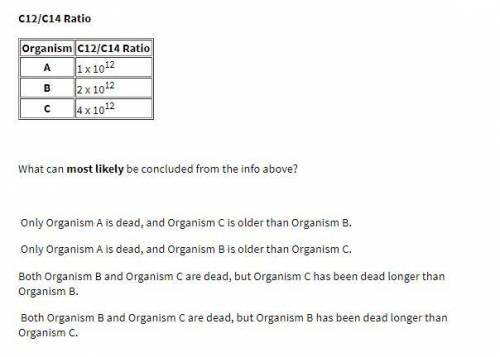
Chemistry, 18.12.2020 08:10 hernandez09297
Studying the decay of radioactive isotopes in dead organisms helps scientists to identify fossilized remains. The ratio of C-12 to C-14 in the atmosphere is 1 x 1012. The table shows this ratio inside the body of three organisms.
C12/C14 Ratio
Organism C12/C14 Ratio
A 1 x 1012
B 2 x 1012
C 4 x 1012
What can most likely be concluded from the above information?
Only Organism A is dead, and Organism C is older than Organism B.
Only Organism A is dead, and Organism B is older than Organism C.
Both Orgamism B and Organism C are dead, but Organism C has been dead longer than Organism B.
Both Orgamism B and Organism C are dead, but Organism B has been dead longer than Organism C.

Answers: 2
Another question on Chemistry

Chemistry, 21.06.2019 22:30
Which supports the idea that birds and butterflies both have wings but they do not have a common ancestor with wings? a. the wings are analogous structures that evolved differently and do not have a similar internal structure. b. the wings are homologous structures that evolved differently and do not have a similar internal structure. c. wings of birds are vestigial structures, but the wing structures of bats are not vestigial. d. wings of bats are vestigial structures, but the wing structures of birds are not vestigial
Answers: 1

Chemistry, 22.06.2019 10:50
A100 kmol/h stream that is 97 mole% carbon tetrachloride (ccl4) and 3% carbon disulfide (cs2) is to be recovered from the bottom of a distillation column. the feed to the column is 16 mole% cs2 and 84% ccl4, and 2% of the ccl4 entering the column is contained in the overhead stream leaving the top of the column. calculate the mass and mole fractions of ccl4 in the overhead stream, and determine the molar flow rates of ccl4 and cs2 in the overhead and feed streams. 12. mw_ccla- 153.82; mw_cs2-76.14.
Answers: 3

Chemistry, 22.06.2019 14:00
The two naturally occurring isotopes of chlorine are 35cl (34.969 amu, 75.77%) and 37cl (36.966 amu, 24.23%). the two naturally occurring isotopes of bromine are 79br (78.918 rm amu, 50.69%) and 81br (80.916 amu, 49.31%). chlorine and bromine combine to form bromine monochloride, brcl. 1. how many peaks will be present in a mass spectrum for brcl? the four combinations of molecule possible given these four isotopes are: 81br37cl, 81br35cl, 79br37cl, and 79br35cl. 2. what are the masses of the four different brcl molecules? express the masses using six significant figures, in decreasing numeric order (highest to lowest), separated by commas.
Answers: 3

Chemistry, 22.06.2019 22:30
The diagram shows the relationship between scientific disciplines.the names of some scientific disciplines have been removed from the boxes. which scientific discipline belongs in the blue box? a.physics b.biology c.chemistry d.metallurgy
Answers: 2
You know the right answer?
Studying the decay of radioactive isotopes in dead organisms helps scientists to identify fossilized...
Questions

Mathematics, 02.11.2020 21:50


Mathematics, 02.11.2020 21:50

Mathematics, 02.11.2020 21:50

History, 02.11.2020 21:50

Mathematics, 02.11.2020 21:50


Health, 02.11.2020 21:50




English, 02.11.2020 21:50

History, 02.11.2020 21:50

Computers and Technology, 02.11.2020 21:50

Health, 02.11.2020 21:50



Mathematics, 02.11.2020 21:50

Mathematics, 02.11.2020 21:50

English, 02.11.2020 21:50




